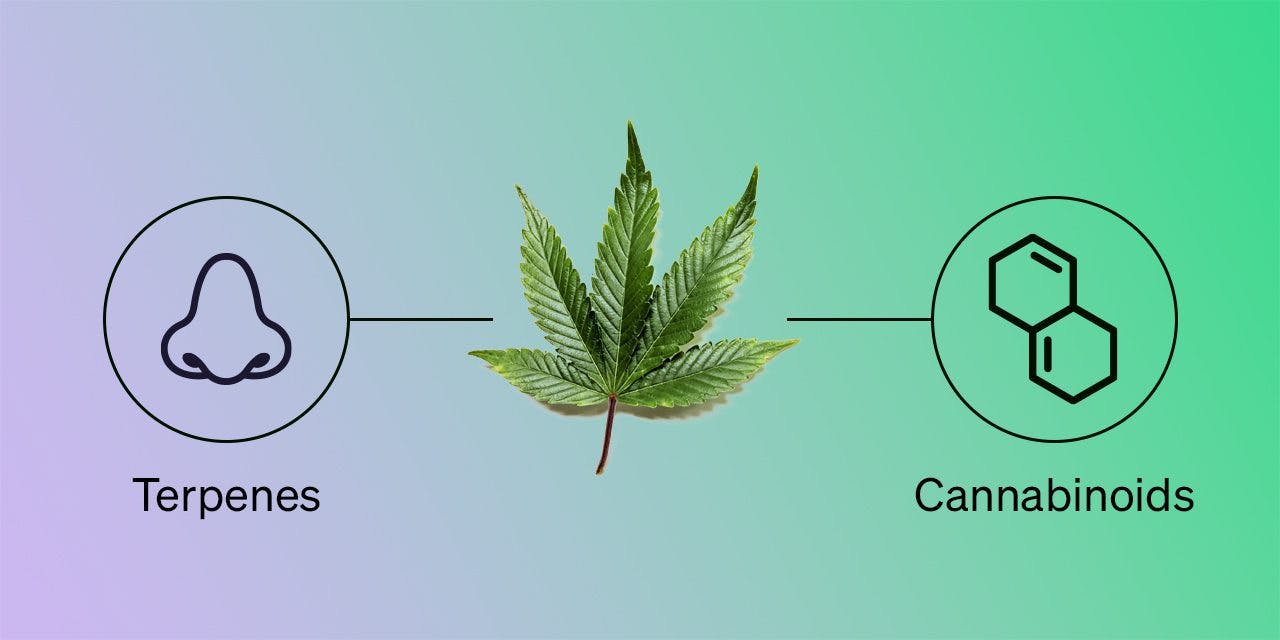What’s the Difference Between Terpenes and Cannabinoids?

Article written by

Dipak HemrajHead of Research and Education
Content reviewed by

Dr. Lewis JasseyMedical Director - Pediatric Medicine
Cannabinoids and terpenes are organic compounds that both exist in the cannabis plant.
However, they have many differences, the most tangible being that terpenes have strong aromas and cannabinoids do not. Terpenes also exist in abundance in almost all plants, while cannabinoids exist mostly in cannabis plants (although black pepper, echinacea and some other plants contain cannabinoids). Regarding legality, cannabinoids are illegal at concentrations of 0.3% or more. Many terpenes are legal and are included in household products such as perfumes and cleaning supplies.
Cannabinoids also have an effect on the endocannabinoid system (ECS), whereas terpenes do not. However, terpenes do affect other receptor systems in the body, so they can contribute to the entourage effect. Terpenes may also influence how cannabinoids behave in the body, even if they do not affect the ECS directly. This means that the terpene makeup of a variety of cannabis is very important to determining the effect a particular cultivar (chemotype) of cannabis has.
Also, it should be pointed out that cannabinoids and terpenes are both technically in a large class of chemical compounds called “terpenoids.” Cannabinoids in cannabis (phytocannabinoids) are derived from a diterpene structure. This means that the two classes of compounds are more similar than we might initially think. It is also possible that terpenes can have a “cannabimimetic” effect, meaning that they can approximate the behavior and feeling of cannabinoids without necessarily affecting the ECS directly.
Get your medical marijuana card
Connect with a licensed physician online in minutes.
What Are Cannabinoids?
Cannabinoids are chemical compounds that modulate the endocannabinoid system. They are classified as either phytocannabinoids, meaning they are produced by plants such as cannabis, or endocannabinoids created by the human body. Studies suggest there are around 150 different cannabinoids. Some man-made synthetic cannabinoids and compounds mimic the different effects of cannabis, called “cannabimimetics.”
Download Free Guide to the ECS
How Do Cannabinoids Work?
Cannabinoids work by interacting with cannabinoid receptors. When a cannabinoid binds to a receptor, a chain reaction produces many physiological and psychological effects. These receptors come in two known variants, CB1 and CB2, and are spread throughout the human body and brain. The following are examples of common cannabinoids.
Tetrahydrocannabinol
Tetrahydrocannabinol (THC) is the most known cannabinoid and is credited for cannabis products’ psychoactive effects. While many people enjoy this cannabinoid for the high it produces, it has many other uses. Studies of THC products show efficacy in cancer treatment, chronic pain reduction, Alzheimer’s Disease treatment (in combination with CBD) and Parkinson’s Disease symptom reduction. This cannabinoid also stimulates appetite, which may help treat appetite reduction disorders.
Download Free Guide to THC
Cannabidiol
Cannabidiol (CBD) is often considered the “medicinal cannabinoid,” However, this is a misleading label as THC also has therapeutic applications.
Products with CBD have been effective in promoting the growth of new brain cells, reducing brain inflammation and alleviating neuron damage, among other brain benefits. Other therapeutic uses have also been discovered, including treating autoimmune encephalitis, multiple sclerosis, anxiety, and chronic pain.
Download Free Guide to CBD
Cannabinol
Cannabinol (CBN) is a metabolite of THC, often nicknamed the “sleepy cannabinoid” for its usefulness in treating insomnia. Studies indicate its strength as a peripheral analgesic, an effective treatment for glaucoma, and a way to delay the onset of amyotrophic lateral sclerosis.
Download Free Guide to CBN
Cannabigerol
Cannabigerolic acid (CBGA) is a precursor to THCA and CBDA, which become CBG, THC and CBD when heated. Some benefits of CBG include appetite stimulation, which can cause a person’s food intake to more than double. This effect can benefit in cases such as wasting syndrome (cachexia). CBG may also be useful for reducing neuroinflammation, slowing cancer development, and treating inflammatory bowel disease (IBD).
What Are Terpenes?
Terpenes are a group of hydrocarbon-based aromatic compounds produced by many plants, most famously the cannabis plant. They are often considered responsible for the flavor and scent profiles of cannabis; however, studies suggest they can also have profound therapeutic effects. There are approximately 30,000 terpenes across plant species, 220 of which exist in cannabis.
How Do Terpenes Work?
Terpenes work by binding to various receptors, including GABA receptors, adenosine receptors, and cannabinoid receptors themselves, in the case of beta-caryophyllene. The following are examples of common cannabis terpenes.
Pinene
Pinene, as you might expect, is a terpene with a pine-like aroma. It is found in cannabis, pine trees, rosemary, and basil. Similar to other terpenes, pinene has profound anti-inflammatory effects when applied topically. It also reduces UV damage to skin and DNA when applied topically. With pinene injection, individuals have also demonstrated a reduced volume of stroke-related brain damage.
Myrcene
Myrcene is another terpene commonly found in cannabis. It has an earthy spiced flavor and exists in many fruits, herbs and essential oils. Studies suggest myrcene produces some of cannabis’s sedative effects. It can also reduce peripheral pain and slow cartilage degeneration in osteoarthritis. It may also reduce cell death in the lung tissue of those with lung cancer.
Linalool
Linalool is common in both cannabis and lavender flowers. It produces a sweet floral scent in some cannabis strains and is responsible for anxiety-reducing effects. Similar to myrcene, this terpene has pain-relieving and sedative properties.
Limonene
Limonene is a citrus-scented terpene found in the peels of lemons and oranges. It also exists in cannabis, where it is commonly thought to produce energizing effects. It has been used in low energy, such as chronic fatigue syndrome and depression. It also demonstrates effective reduction of cancerous tumors, especially in breast cancer.
Eucalyptol
Eucalyptol has a cooling and minty scent. This provides the refreshing taste in cannabis, rosemary, wormwood, bay leaves, and its namesake, eucalyptus. Perhaps unsurprising if you’ve ever used eucalyptus to treat a cold, eucalyptol is beneficial in treating many respiratory disorders, such as asthma, bronchitis, and rhinosinusitis. As part of an essential oil, eucalyptol has also demonstrated antitumor effects and an ability to improve cognitive function in older individuals.
Beta-Caryophyllene: The Terpene That’s Also a Cannabinoid
Beta-Caryophyllene (BCP), or the “pepper terpene,” has a distinctive warm woody scent. BCP is unique as it behaves as both a terpene and cannabinoid, binding to CB2 receptors, as mentioned above. This means it can modulate the endocannabinoid system while producing an aroma and other physiological effects. Like other terpenes and cannabinoids, BCP has many therapeutic possibilities, including anxiety reduction, increased wound healing, and anti-inflammatory properties.
Download Free Guide to Beta-Caryophyllene
How Do Cannabinoids and Terpenes Work Together?
While the terpenes and cannabinoids in cannabis differ, they are not discrete. These two organic compounds cooperate in a phenomenon called the entourage effect. This occurs when terpenes and cannabinoids act synergistically to modulate the overall effect of the cannabis consumed. It is commonly considered that the full spectrum of cannabis-related compounds (terpenes, cannabinoids, etc.) are required to produce the varied effects of cannabis.
Terpenes can change how much THC crosses the blood–brain barrier and modulate its effects. This interaction can greatly benefit cannabis users. Knowledgeable individuals can predict with some accuracy what kind of effect cannabis will have by examining the types and amounts of terpenes and cannabinoids in the product.
Although terpenes may influence how cannabinoids work, and there are many similarities in chemical structure, there is currently no evidence that terpenes act on the endocannabinoid system directly, except beta-caryophyllene. However, terpenes act on many other receptor systems throughout the body, including serotonin, dopamine and GABA receptors. This means that terpenes can contribute to the entourage effect in different ways.
The Bottom Line
While cannabinoids and terpenes have their differences, they work together to modulate the overall effect of cannabis. This “teamwork” provides significant benefits to cannabis users and is a promising avenue for further research.
Get Your Medical Card
Connect with a licensed physician online in minutes.
Frequently Asked Questions
Is CBD the same as terpenes?
While CBD and terpenes both lack the intoxicating effect of THC, they are different. CBD is a cannabinoid, while terpenes (except for beta-caryophyllene) are aromatic compounds and are in a completely different category. However, both can be extracted from the cannabis plant.
Should I take CBD or terpenes?
Whether you should ingest CBD or terpenes depends on your goals. Neither CBD nor terpenes are intoxicating; however, they have different benefit profiles. Users often report that when they use a combination of CBD and terpenes, they experience more benefits than using either individually.
Which terpene is also a cannabinoid?
Beta-caryophyllene is both a terpene and a cannabinoid. It produces a peppery scent and acts on the CB2 receptors within the endocannabinoid system. BCP is well known for its anti-inflammatory and anxiety-reducing properties.



